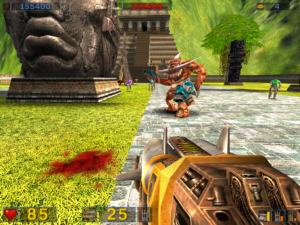Bioshock: Stupid?
Coincidentally, there was some discussion of Bioshock at my workplace the other day. (Steam had put it on sale for Halloween.) One person insisted that it was “stupid”, and others rushed to defend it. I tried to argue on the stupid side, just to balance things out a little, and to that end adapted some of what I said in my last post — essentially, that it’s sensationalistic, and the line between sensationalism and stupidity is so fine that I’m not even sure it’s there. In addition, Objectivism is a basically stupid philosophy, by which I mean that adhering to it necessarily involves forgetting or ignoring a lot of what you know about humanity, and often seems to also involve other sorts of idiocy like pretending that you can derive practical information from a tautology like “A is A”. This is the sort of stupid that you can’t even argue against intelligently; just taking it seriously enough to engage it lowers the level of discourse. Bioshock certainly engages it, but perhaps not seriously enough to be affected. The chief argument it employs is “O NO YOU ARE BEING ATTACKED BY MONSTER PEOPLE”, which is kind of dismissive. Or perhaps just kind of stupid.
But this isn’t what the accuser in this discussion meant. He wasn’t thinking about the style or the theme, but about the gameplay. This is a game that imposes no penalty for dying, which, to him, meant there was no motivation for playing skillfully or learning new techniques. His knock-down argument was that he claimed he had beaten the game on the Hard difficulty setting using no weapon or plasmid other than the wrench that you get early on as your default melee weapon. It didn’t make a difference, he said, because enemies don’t heal when you respawn, so you can just whittle them down to nothing no matter how often they kill you. Thus, the game is stupid.
Now, I have my doubts about the veracity of his claims. I myself took a few wrench-swings at Dr. Steiner, the game’s first boss-like enemy, and I could have sworn that he was back at full health by the time I got back from the vita-chamber. Perhaps there was a health dispenser I failed to notice. Regardless, everyone present, including myself, felt that he was approaching the game wrong. I recognize that everyone’s different, and that not everyone who plays games plays them for the same reasons, or derives the same sorts of satisfaction from them. No game will appeal to everyone. But even bearing this in mind, it seemed like his poor experience of the game was his own doing, the result of a willful refusal to appreciate its merits.
It was argued that Bioshock is about the setting and story rather than about the challenge, and as far as that goes, I can’t disagree. A colleague of mine once said about Quake that it wasn’t really a game about shooting, but rather, a game about 3D environments. The shooting was just there to give you something to do in those environments. You can say the same about most first-person shooters, to varying degrees. Some are more about action, some are more about place. Bioshock is very much about place. But this isn’t a very satisfying excuse. If you’re going to fill your decaying underwater city with combat set-pieces, surely you can at least provide interesting combat mechanics?
But that’s where the argument for stupid breaks down. The game does provide interesting mechanics; my colleague just refused to use them, and the game never forced the issue. Again, people enjoy different things, and the game recognizes this by allowing you to take different approaches. If you enjoy sticking with the wrench, killing things by degrees and dying a lot, it gives you that option. If you don’t enjoy playing it that way, why do it? The fact that the game lets you respawn without resetting the game state doesn’t mean you have to take advantage of it.
I’m reminded of my experience with Final Fantasy 8. This is a game that gives you access to powerful summoning spells from near the very beginning, and lets you cast them at a much lower cost than in other Final Fantasy games. Thus, for most of the game, you can pretty much just do a summon at the beginning of every combat to win them all trivially. A lot of people did this, and consequently decided that the game was stupid. So when I played, I made a point of not doing it that way. As a result, I probably had a more satisfying experience than most players.
So, this all got me thinking. I had already been doing more dying than I liked in Bioshock. Even if it’s without consequence, it’s a kind of failure. So I’m replaying from the beginning, trying to avoid dying entirely, or at least minimize it. To support this, I’m dialing the difficulty down from Hard to Normal. The game recommends Normal if you’ve played shooters before and Hard if you’ve played a lot of shooters before, and so, although I don’t consider myself skilled by multiplayer standards, I figured I qualified for Hard just on the basis of long experience. But that was without my new handicap. Restarting also gives me the luxury of making decisions differently, and in particular, choosing different plasmids. The first time through, when I had the opportunity to purchase the Rage plasmid, which makes enemies attack each other, I instead purchased a couple of others that would make normal gameplay easier (for example, one of them was simply armor against physical damage). That might have been important under Hard, but at this point I think the better way to play this game is to choose things that make the game interesting instead of things that make it easy.
 Comments(9)
Comments(9)